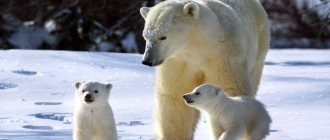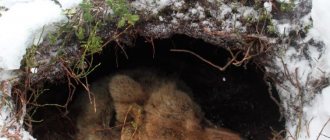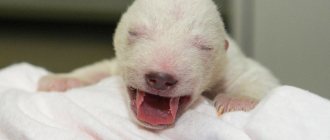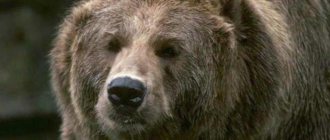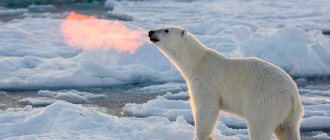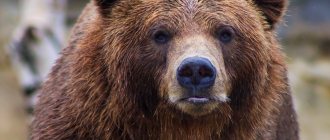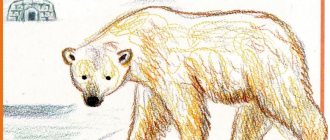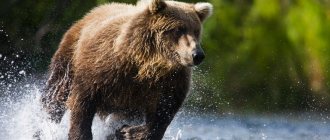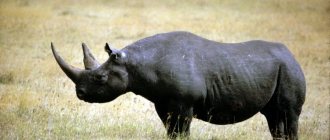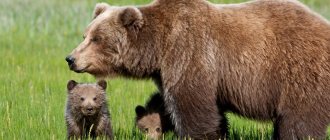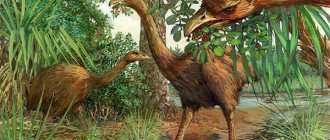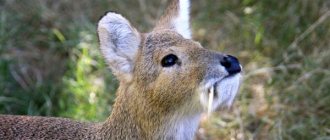cave bears lived in Eurasia . They were 30% larger than modern brown bears and differed from modern individuals in the shape of their foreheads and the arrangement of their teeth. Like modern bears, they mainly ate vegetation and honey, but in some cases they could attack Neanderthals. Bloody battles especially often took place inside caves, because they served as a refuge for both huge predators and ancient people. It would be logical to assume that cave bears were exterminated by our ancestors, but recently scientists from the USA, Spain and Australia found that they became extinct for a completely different reason.
Cave bears often encountered ancient people and died under the blows of sharp spears
Cave bears (Ursus spelaeus) are the ancestors of brown bears that went extinct about 15,000 years ago. They lived in caves and were often hunted by Neanderthals. I talked about how our ancestors killed these giants in this article
Origin and characteristics of bears
Mammals belong to the group of canids. Today it has been established that animals can grow from 1.2 to 3 meters, their weight can vary from 40 kg to 1 ton. Some species are predators, while others feed on plants, berries and other delicacies. The average lifespan of an animal is 45 years.
There are several classifications of bears, which differ in the size of the animals, their habitat and other features. Let's look at some of them.
Social structure and reproduction
Photo: Prehistoric cave bear
Female cave bears gave birth not every year, but once every 2-3 years. Like modern bears, puberty ended around the age of three. The female gave birth to 1-2 cubs during one pregnancy. The male did not take any part in their life.
The cubs were born completely helpless and blind. The mother always chose caves for the den so that there was a source of water in it, and the trip to the watering hole did not take much time. Danger lurked everywhere, so leaving your offspring unprotected for a long time was dangerous.
For 1.5-2 years, the young animals were next to the female and only then went into adulthood. At this stage, most of the cubs died in the claws of other predators, of which there were a lot in ancient times.
Interesting fact: Back in the early 18th century, paleontologists found unusual polished clay slides on the banks of mountain lakes and rivers in caves in Austria and France. According to experts, cave bears climbed onto them during long underground journeys and then rolled into bodies of water. In this way they tried to fight the parasites that plagued them. They carried out this procedure many times. Quite often there were traces of their huge claws at a height of more than two meters from the floor, on ancient stalagmites in very deep caves.
Main types of bears
You can meet a bear almost everywhere, be it the steppes, highlands, forests or Arctic ice. There is a basic classification of mammals:
Brown bear
Brown bears live in tundras, forests, coastlines and alpine meadows. Animals hibernate in winter and are quite aggressive if someone disturbs their sleep. It is almost impossible to escape from a predator.
Video about brown bears
Grizzly
Grizzly bears are one of the largest predators on the planet. The maximum height of a bear can be 2.8 meters, weight - more than 600 kg. This representative of the family loves fish and is an excellent fisherman.
Video about Grizzly bear
Spectacled bear
The spectacled bear is a herbivorous animal. A characteristic feature of the mammal is the white spots located around the eyes. The animal is also distinguished by a rounded head and a short snout. You can meet a bear in South America.
Video about the spectacled bear
Gubach
Sloth bear (or sloth bear) - the animal received its name due to its pronounced and mobile lips. The bear differs from its “brothers” by its hard, shaggy fur coat and white muzzle. Today, the sponge fish is listed in the Red Book, as it is on the verge of extinction. The habitat of the mammal is India.
Video about sloth fish
Biruang (Malayan bear)
Biruang or Malayan bear is one of the smallest bears. You can meet it in Asia. A distinctive feature of the animal is its black coat and yellow horseshoe on its chest, which is why it is often called the sun bear. This species of the family is excellent at climbing trees thanks to its sharp claws, with which it can easily cling to the bark. Despite the small size of the animals, they are considered the most aggressive among the members of the family.
In some states, people keep bears at home as guard dogs. Miniature mammals live in countries such as India, China, Indonesia and Thailand. The bear of this species is listed in the Red Book.
Video about the Malayan bear
Polar bear (polar)
The polar bear is one of the most dangerous animals on the planet. An adult animal can grow up to 2.6 m. Mammals have huge and strong paws, unwebbed toes and unique soles that allow them to walk on ice without slipping.
Video about a white polar bear
Baribal
Baribal (black bear) is a rather loving and friendly bear. The animal can hibernate for seven months. He prefers to eat fruits, plants and nuts, although he is not averse to eating meat and insects.
Black bear video
Big panda
The giant panda (bamboo bear) is one of the most vulnerable species of the family on the planet. The panda has a white coat with black ears, limbs and shoulders. Large dark spots under the eyes also distinguish mammals from others. You can meet a human pet in China, the outskirts of the Tibetan Plateau and in special establishments all over the planet where pandas are bred.
Video about the big panda
Himalayan bear
The Himalayan bear is considered one of the less dangerous bears for humans, since the animal can attack only if it is protecting its cubs or is seriously injured. The mammals have a round head, large ears and a yellow crescent-shaped patch on the chest. The bear's muzzle is light, its coat is dark. As a rule, the animal does not hibernate, but may deliberately fall asleep to wait out harsh weather.
Video about the Himalayan bear
Representatives of the same family are radically different from each other not only in their habitat, but also in their diet, appearance and vital activity.
White-breasted or Himalayan bear genus
This is another species in the genus of bears. Its representatives are also called white-breasted. And this is true. After all, they have a large white fur triangular mark on their chest. The color of their coat is black, sometimes with a brownish or reddish tint. They are smaller in size than brown bears.
Even males, standing on two legs (which happens quite often among bears), can only be as tall as a tall person. And the female half is one and a half times smaller (however, such gender differences remain in all clubfoot).
Himalayan bears are better at climbing trees than brown bears. There they spend most of their lives, hiding from enemies and getting food: berries, pine nuts, acorns. Therefore, it is useless to climb a tree when running away from this animal.
Brown giants are not always ready to climb tree trunks, but rather stand on their hind legs and shake them with all their might so that the fugitive falls from above. But the Himalayan compact bear can easily climb to the top to achieve its goal.
This species is found in Western Asia and further along the mainland to the east through Tibet and the Khabarovsk Territory all the way to Japan. But despite their extensive range, the number of such bears is small. The species is now protected. But earlier, uncontrolled shooting of its representatives was carried out for the sake of meat and healing fat; the skin and paws were also considered valuable.
Ussuri subspecies
From the name you can guess that representatives of the subspecies live mostly in the Ussuri region, that is, in the south of the Far East. These are mountainous places with rich nature, hot summers and long, cold winters. There, bears are found in cedar, oak and broad-leaved forests, in river valleys and on mountain slopes close to them. In search of food, they move two to three hundred kilometers. Winter dens are often made in caves and tree hollows.
For white-breasted bears, Ussuri bears are considered quite large. Their numbers are catastrophically low (no more than 8 thousand individuals). Nature reserves are being created in the region to protect rare animals.
Other species of bears
In addition to the main group, which includes the above animals, there are other types of bears, including:
Little panda
Red panda - previously the animals were classified as raccoons, because in appearance they look like big cats. Today, the red panda is considered a bear, since its character is similar to this family.
Grolar
Grolar (polar Grizzly) is a predatory animal that is a hybrid of a polar and brown bear. This species combines the characteristics of a Grizzly bear: inconspicuous facial features, spots near the nose and eyes, strong claws, but the individuals have light-colored fur and behavior very similar to that found in polar bears. It is important to note that the genetics of the “parents” have many common features, so the hybrid turned out to be quite harmonious. These bears are not very common in the wild, but they usually live in places with low temperatures and harsh weather conditions. The Grolar diet consists entirely of meat, and the animals themselves are aggressive and cautious.
Brown panda
This is a subspecies that belongs to the order of carnivores. It was discovered in the second half of the last century, but scientists attributed it to the Qinling population of Ailuropoda melanoleuca for a very long time, and after 45 years it was still identified as a subspecies. The size of individuals is slightly smaller than that of black and white pandas. Another distinctive feature is the brown or light brown color. The animals also have a small skull and massive molars. The number of animals is extremely small - there are 300 individuals in total; they reproduce very reluctantly, which makes it difficult to increase the population. Brown pandas typically live in the Qinling Mountains in China and feed on bamboo.
Risk of encountering a bear
It is important for a hunter to understand what a bear’s track looks like and how many toes a bear has in order to be aware of its presence and avoid encountering a predator. These animals are unpredictable, differ from others in their lightning-fast reaction to incorrect human behavior. Usually any wild animals avoid humans and bypass them.
Rarely has anyone been able to meet such an animal in the forest, even in places where they have large concentrations. But there are situations when there was a chance meeting on the leeward side. A bear can attack only in case of severe hunger in early spring, protecting cubs, during the rutting period, when males are unusually aggressive and excited, or if the animal is wounded. In winter you can find a dangerous connecting rod. This is an animal whose sleep has been interrupted for some reason.
Extinct bears
There are several representatives of the mammal family that, unfortunately, became extinct and could not preserve their species to this day. These include:
California grizzly - in 1922, the last representative of this species of animals was killed.
Mexican grizzly
The Mexican grizzly left our planet in the 60s of the 20th century. The bear's characteristic features were white claws on its front paws, small ears and a high forehead.
Etruscan bear - there is a second name for the animal - short-faced. Disappeared about 2.5 million years ago.
Atlas bear - the last animal was killed in 1870. A distinctive feature was a white spot on the muzzle and fur that shimmered in red.
Giant polar bear
Giant polar bear - the animal is believed to have grown up to 4 meters and weighed about 1200 kg. Mysterious giants lived more than 100 thousand years ago.
Gubach family
The genus, species and name of this bear, which lives in the jungles of South Asia, are the same. Let us immediately note that these creatures differ significantly from other representatives of the Bear family. Perhaps they would have looked more like ridiculous dogs with long black hair if not for their size (length about 180 cm and height at the withers on average 75 cm). But the most important thing is that their strength is not at all that of a bear; they are too weak to fight serious predators.
The elongated, mobile, naked muzzle, that is, not at all typical for clubfoot, also looks strange. And the lips, which can protrude quite strongly, seem in this position to resemble a proboscis. But this absurdity of appearance also hides the wisdom of nature.
It's all about the evolutionary adaptation of the structure to the taste preferences of these animals. After all, they mainly eat the inhabitants of anthills and termite mounds. And in them it is more convenient to rob with a bare snout and sucking in its prey through the proboscis lips. Rumor has it that the noise during such feasts is so deafening that the sound travels one and a half hundred meters.
Lifestyle
Bears lead a sedentary lifestyle. Each individual lives in its own marked territory. The exception is small flocks consisting of cubs and their mother. A female bear gives birth to one or two cubs every 3-4 years. She independently takes care of her offspring until they reach 3 years of age. Older cubs watch over their younger brothers and sisters. Animals rarely migrate over long distances, only in cases of food shortage or in search of an individual for mating.
With the onset of cold weather, adult bears look for a den for themselves to hibernate. However, individuals that have not had time to accumulate the necessary amount of fat to survive the winter do not hibernate. Throughout the cold season, they wander around the territories in search of food. At this time they are the most aggressive and dangerous.
Polar bears are an exception. They do not strongly adhere to a sedentary lifestyle - they roam, explore and develop new territories.
Where did the cave bear live?
Photo: Cave bear in Eurasia
Cave bears lived in Eurasia, including Ireland and England. Several geographical races were formed in different territories. In numerous alpine caves, which were located at an altitude of up to three thousand meters above sea level, and in the mountains of Germany, predominantly dwarf forms of the species were found. On the territory of Russia, cave bears were found in the Urals, the Russian Plain, the Zhiguli Upland, and in Siberia.
These wild animals were inhabitants of wooded and mountainous areas. They preferred to settle in caves, where they spent the winter. Bears often descended deep into underground caves and wandered around them in complete darkness. To this day, in many remote dead ends and narrow tunnels there is evidence of the presence of these ancient creatures. In addition to claw marks, half-decayed skulls of bears were found on the vaults of caves, which got lost in long passages and died without finding their way back to sunlight.
There are many opinions about what attracted them to this dangerous journey in absolute darkness. Perhaps these were sick individuals who were looking for their last refuge there, or the bears were trying to find more secluded places to live. The latter is supported by the fact that the remains of young individuals were also found in distant caves ending in dead ends.
What do bears eat?
Bears are at the top of the food chain. They are omnivores. Depending on the species and habitat of the individual, their diet may include: nuts, berries, roots, frogs, rodents, fish, shellfish, deer meat, roe deer, moose and even carrion. Honey and berries are more of a treat for the animal than a complete diet.
Even though bears are omnivores, they are primarily carnivores. But at the same time, 75% of their diet may consist of food of plant origin. The exception is polar bears; they eat exclusively meat.
Giant pandas
We have already come to the end of our story and looked at many types of bears in the photo . And our last heroes are very bright and interesting representatives of the Earth’s fauna. And these are not just words, they are confirmed by facts, because these animals are officially awarded the title of the cutest on the planet.
They live in the mountainous regions of China and are the symbol and pride of this country. They are also called bamboo bears, which seems to prove their relationship with clubfoot. However, many believe that they are also relatives of raccoons. Others believe that these representatives of the fauna are not even bears, but rather on their own.
The body length of pandas is about 2 m, the approximate weight is 150 kg. Their fur outfit is original and composed of alternating white and black areas. Their diet consists mainly of bamboo. In nature, they deftly climb trees and feel confident in the water. Unpretentious in captivity.
Interesting facts about bears
Bears are amazing representatives of the animal world. Each species has its own characteristics, but they are very similar to each other. It seems that we know everything about these animals. However, we have prepared 20 facts about bears that you might find interesting.
- The largest representative of bears is the polar bear. The weight of individuals of this species can reach up to 800 kg.
- Not all types of bears tend to hibernate. The exception is polar bears. In representatives of this species, only pregnant individuals hibernate.
- Bears appeared 5-6 million years ago. For animals this is a fairly short period of time compared to other species.
- Bears are capable of throwing stones or sticks into hunting traps to disarm them.
- Polar bears are very good swimmers. A distance of tens of kilometers by water is not a hindrance for them.
- Bears are really good at climbing trees, but only young individuals do this. Adults - only if absolutely necessary.
- Bears can reach speeds of up to 55 km/h.
- A bear can lose half its weight during hibernation.
- In order not to stand out against the background of snow, polar bears cover their noses with their paws when they hunt, since this is the only black mark that can give them away.
- The bear has two layers of fur. The first protects against water, the second has the function of heat regulation.
- 70% of all bears living on earth live in the United States and Canada.
- The age of a bear can be determined by its teeth, much like the age of a tree is determined by its rings.
- The weight of a newborn bear cub is approximately half a kilogram.
- Hibernation of bears can last not only winter, but as much as six months, depending on the habitat of the individuals.
- One meal of an adult bear can amount to up to 70 kg of meat.
- Bears do not live in Africa, Australia and Antarctica.
- The pulse of bears in a normal, normal state is 35-45 beats per minute.
- During the times of ancient Rus', bears were considered sacred animals.
- Bears are smart animals. They are believed to be more intelligent than dogs. Individuals respond well to training. In this regard, nowadays almost every circus hosts performances with bears.
- Bears really love honey and often rob bee hives. They can smell such a catch 7-9 kilometers away. They are practically not afraid of bees; two layers of wool protect them from stings. The only weak point of bears is their nose. If the bite lands there, they experience severe pain, which can last a week, or even more than one.
Appearance and features
Photo: What a cave bear looks like
Modern bears are much inferior to cave bears in weight and size. Such large modern animal species as the grizzly bear or the Kodiak bear are more than one and a half times smaller than the prehistoric bear. It is believed that it was a very powerful animal with well-developed muscles and thick, fairly long brown hair. In the ancient clubfoot, the front part of the body was more developed than the back, and the legs were strong and short.
The bear's skull was large, its forehead was very steep, its eyes were small, and its jaws were powerful. The body length was approximately 3-3.5 meters, and the weight reached 700-800 kilograms. Males significantly outweighed female bears. Cave bears did not have front false-rooted teeth, which distinguishes them from modern relatives.
Interesting fact: The cave bear is one of the heaviest and largest bears that have lived on Earth throughout its existence. It was he who was the owner of the most massive skull, which in large mature males could reach 56-58 cm in length.
When he stood on all fours, his shaggy, powerful scruff was at the level of the caveman's shoulder, but, nevertheless, people learned to successfully hunt him. Now you know what a cave bear looked like. Let's see where he lived.
Natural enemies
Adult predators have almost no enemies in their natural habitat. But young representatives of this animal species can become victims of other bears, canines or cats.
Animals do not pose any particular danger to humans, but they are often hunted. Their fat and bile are used in the medical field, carpets are made from animal skins, and their meat is edible. Sometimes predators wander into agricultural plantations and cause significant damage. A bear can attack a person; females with cubs are considered the most dangerous. Due to human shooting of these animals, several of their species are considered endangered and are listed in the Red Book - the giant panda, the Himalayan bear, the polar bear and the spectacled bear.
Delayed implantation is typical for all types
Mother bears give birth to 1 to 4 cubs, but more often than not, two. The duration of pregnancy ranges from 95 to 266 days, with a delay in implantation from 45 to 120 days. The actual length of pregnancy is usually between 60 and 70 days.
In species from temperate climates, births occur in January or February, when the female is at rest. The cubs nurse, and all of the female bear's metabolic needs are met from her fat reserves. Malayan bears can give birth at any time of the year.
Photo: Arco/W. Rolfes/Alamy
Females give birth to their young in protected areas, often in a den of some kind. They stay there for several months. Cubs are very small at birth, ranging from 90 to 680 grams. Newborns are about 23 cm long from the nose to the tip of the short tail. They are born with their eyes and ears closed, naked or with a thin layer of fur. Bear cubs grow quickly; polar bears increase their weight from 600 grams to 10-15 kg in 4 months. Weaning occurs after 4-9 months. The young remain with their mother for up to 3 years, but in most species the cubs separate after 18-24 months.
Bears are found on every continent except Antarctica and Australia
They are mainly found throughout the Northern Hemisphere. Previously, the bears' range extended as far south as the Atlas Mountains of northwestern Africa, the Andes of South America, and the Sunda Shelf. This range has been reduced as a result of human persecution and habitat destruction. For example, brown bear (Ursus arctos) populations in the Atlas Mountains are thought to have been extirpated, and their range in North America and Europe has been significantly reduced. The spectacled bear (Tremarctos ornatus) of the South American Andes is the only bear species found south of the equator.
Photo: www.tropicalherping.com
Not all bears actually hibernate
Some temperate bear species experience long periods of torpor during the winter, retreating to underground burrows or caves to escape temperature fluctuations. They become lethargic and metabolize fat reserves accumulated in summer and autumn. Some physiologists do not consider this to be a true state of hibernation because body temperature does not drop significantly and bears can be easily brought out of this state. Other scientists consider the difference to be semantic, and some researchers have suggested that this is true hibernation because the heart rate drops to almost half normal. Bear species that enter this form of hibernation often give birth during hibernation.
